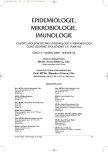Congenital Toxoplasmosis: Possibilities for Laboratory Diagnosis
Authors:
Z. Čermáková 1; P. Prášil 2; O. Ryšková 1
Authors‘ workplace:
Ústav klinické mikrobiologie Univerzita Karlova v Praze
1; Klinika infekčních nemocí Lékařská fakulta a Fakultní nemocnice v Hradci Králové
2
Published in:
Epidemiol. Mikrobiol. Imunol. 54, 2005, č. 2, s. 75-77
Overview
A case history and the steps taken in diagnosing congenital toxoplasmosis in a child whose mother experienced asymptomatic infection with the protozoon Toxoplasma gondii are presented. At pregnancy week 35, amniocentesis was performed because of fetal hydrops, ascites, hepatosplenomegaly and dilated left lateral brain ventricle on sonography. Laboratory tests showed high titers of IgM, IgE and IgA antibodies (acute infection markers) against Toxoplasma gondii in serum of the pregnant woman. Congenital toxoplasmosis in the new-born spontaneously delivered at week 41 was confirmed by detection of Toxoplasma gondii DNA in blood, acute infection markers in serum and hydrocephalus and calcifications on brain sonography. The woman received intensive treatment for toxoplasmosis during the last pregnancy trimester and her new-born child’s treatment started immediately after delivery. The accurate diagnosis and early institution of therapy in both the pregnant woman and her child led to progressive normalization of laboratory tests (decreased titers of antibodies and Toxoplasma gondii DNA negativity) and significant regression of the brain lesions in the child.
Key words:
Toxoplasma gondii – congenital toxoplasmosis.
Labels
Hygiene and epidemiology Medical virology Clinical microbiologyArticle was published in
Epidemiology, Microbiology, Immunology

2005 Issue 2
Most read in this issue
- Factors of Virulence and Mechanisms of Resistance to Aminoglycosides in Clinical Isolates of Enterococcus faecalis and Enterococcus faecium with High-level Gentamicin Resistance
- Congenital Toxoplasmosis: Possibilities for Laboratory Diagnosis
- Immunological Monitoring of Sepsis Using Flow Cytometry – Quantitation of Monocyte HLA-DR Expression and Granulocyte CD64 Expression
- Microbicidal Efficacy of a New Foam Disinfectant
